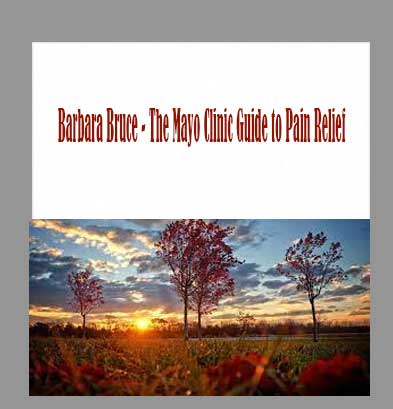Description
Barbara Bruce – The Mayo Clinic Guide to Pain Relief download, Barbara Bruce – The Mayo Clinic Guide to Pain Relief review, Barbara Bruce – The Mayo Clinic Guide to Pain Relief free
Barbara Bruce – The Mayo Clinic Guide to Pain Relief
The Mayo Clinic Guide to Pain Relief
A Mayo Clinic professor shows you science-based lifestyle choices that can help you manage chronic pain.
LECTURE (12)
01:Why Pain Matters
One out of every three people suffers from chronic pain-pain that either never goes away or returns again and again. Although pain is a universal experience, there are ways you can manage pain effectively – and live an enjoyable and fulfilling life. Learn from case studies of people who have dealt with chronic pain and how their experiences may help you.< 02:What Is Pain? The latest neurological research reveals that the brain’s physical, emotional, and cognition centers all play significant roles in our perception of pain. The fascinating neurology of pain reveals why the most effective pain-control programs address the body, the mind, and the body-mind interaction. 03:Common Causes of Chronic Pain Many conditions can lead to chronic pain, but one more recently discovered cause is central sensitization. This syndrome is caused by dysregulation of the spinal cord, the brain’s thalamus, hypothalamus, and amygdala, and alterations in how pain is experienced. Central sensitization is thought to be the underlying cause of fibromyalgia, chronic fatigue syndrome, and more. 04:Medication for Chronic Pain: Why and Why Not What are the short-term benefits and the long-term risks of using anti-inflammatories, analgesics, opioids, antidepressants, anticonvulsants, and other pharmacological treatments for chronic pain? Learn when drugs can be helpful and when it’s time to address the bigger goal of successfully managing chronic pain-and managing life-without them. 05:How Exercise Helps with Chronic Pain Study after study has shown that exercise releases endorphins, improves blood flow to the brain, reduces fatigue, improves sleep quality, and even helps build emotional resilience. But what’s the most significant issue in developing an appropriate exercise program for a person with chronic pain? Moderation. Moderation. And more moderation. Learn why. 06:Manage Your Stress to Manage Your Pain No matter its cause, stress signals your body to release cortisol-its primary fight-or-flight hormone-which increases your perception of pain, causes more stress, and even doubles the symptoms of pain that you experience. Learn how to break this cycle by identifying and reducing the real stressors in your life and adopting new behaviors that reduce stress and pain. 07:Social Support for Pain Management Medical research consistently shows that people with rich social support networks are healthier in almost every way. But you might be surprised to learn what type of social support doctors have found most helpful for those with chronic pain, and who benefits. Learn how to initiate, develop, and nurture these significant relationships. 08:How to Sleep When You Have Pain People with chronic pain are more likely to have sleep problems that impact their daily lives and are three times more likely to be diagnosed with a sleep disorder. Recent research reveals many complex relationships between pain and sleep-and the best ways to get the sleep needed to lessen stress and pain. 09:The Vicious Cycle of Pain and Mood Symptoms of chronic pain are rarely stable, leading to good days and bad days – and unpredictable changes in mood. It’s impossible to completely disentangle chronic pain from mood, especially since the emotions and pain that you feel travel along the same nerve pathways through your body. But help is available for mood disorders, and you can learn how to minimize their impact on your life. 10:Building a Pain Management Team Do you wish you had one person to lead your health care team? One person to coordinate, explain, and integrate information from your other doctors-to explain all your options and develop the best possible pain-management plan for you? You do. Learn why your primary care physician is almost always best for the job. 11:Creating a Pain Management Plan Use everything you’ve learned in the first 10 lectures of this course to create your own effective pain management plan – one that meets your personal goals and identifies the lifestyle interventions that are most appropriate for you in the areas of exercise, stress reduction, social support, improved sleep, and emotional health. 12:Active Sessions: Exercise and Relaxation Begin two aspects of your pain management plan right now. Let experts gently guide you through physical exercise and meditation practices that will start you on your journey. Learn how to calm your busy mind and improve your chances of directing it where you want it to go-toward relaxation and comfort. DETAILS Overview If your life or the life of someone you love has been hijacked by pain, you’re not alone. One out of every three U.S. adults lives with chronic pain. In The Mayo Clinic Guide to Pain Relief with Barbara K. Bruce, Ph.D., L.P., you will learn new science-based behaviors that can lessen your pain, how to build a health care team, and how to create your individualized pain-management program addressing issues of physical stamina, stress management, social support, sleep, and mood. About Barbara K. Bruce “Everyone agrees that pain is a universal human experience, but not everyone knows what to do about it.†ALMA MATER Louisiana State University INSTITUTION Mayo Clinic Barbara K. Bruce, Ph.D., L.P., is a clinical health psychologist in the Mayo Clinic Department of Psychiatry and Psychology, and Associate Professor of Psychology at the Mayo Clinic College of Science and Medicine, Mayo Clinic. She holds a Ph.D. in Clinical Psychology from Louisiana State University in Baton Rouge, where she also earned her Bachelor’s Degree in Psychology. In addition, she holds a Master’s Degree in Physiological Psychology from the University of New Orleans. Dr. Bruce has spent her entire career in the field of pain management. She served as Clinical Director of the Mayo Clinic Pain Rehabilitation Center Program in Rochester, MN, where she also led the development of the Mayo Clinic Pediatric Pain Rehabilitation Program. She is currently located at Mayo Clinic in Jacksonville, FL, where she has developed and currently leads its fibromyalgia and chronic abdominal pain treatment programs. Dr. Bruce is widely published in scholarly journals addressing issues of pain management, including The Clinical Journal of Pain, Clinical Pediatrics, Mayo Clinic Proceedings, and Journal of Pediatric Psychology. Her research interests include the effective treatment for chronic benign pain and cancer pain, controversial use of maintenance opioid therapy in chronic non-cancer pain, and understanding the role of multidisciplinary psychosocial factors in treatment.








